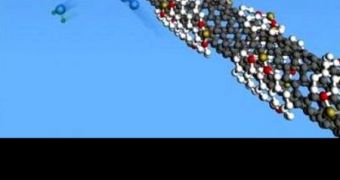Researchers at the Stanford University announce the creation of a new material that may replace platinum in fuel cells and metal-air batteries. They say that carbon nanotubes (CNT) have the potential to provide performances similar to those of platinum, but at much lower prices.
Over the past few years, the price of platinum has ranged from $800 to $2,200 per ounce (28.3 grams). This meant that all devices using this chemical are very expensive as well. Scientists now say that these costs could be reduced by using multi-walled carbon nanotubes (MWCNT).
These structures are covered with defects and impurities on their exterior. Stanford scientists say this is actually very useful for the applications they have in mind for the nanoscale structures. Details of their study appear in the May 27 online issue of the top journal scientific journal Nature Nanotechnology.
MWCNT are obtained by placing three or four single-walled carbon nanotubes inside each other. The latter are made up of a rolled sheet of graphene, a bi-dimensional carbon compound that has some remarkable physical and chemical properties.
One of the most remarkable things about nanotubes is that they are roughly 10,000 times narrower than a human hair. The multi-walled version can handle having one or two of its outer layers sectioned, without losing its ability to transfer electricity through the inner tubes.
This capability enhances their uses as catalyst, to the point where researchers can seriously consider replacing platinum, which is “very expensive and thus impractical for large-scale commercialization,” explains researcher Hongjie Dai.
The expert, a coauthor of the new paper, holds an appointment as a professor of chemistry at the university. “Developing a low-cost alternative has been a major research goal for several decades,” the investigator goes on to say, quoted by EurekaAlert.
Dai explains that, while many researchers usually seek to create pure nanotubes, creating MWCNT that have defects and impurities on their outer layers is actually very important for their ability to act as catalysts between various other chemicals.
“A typical carbon nanotube has few defects. But defects are actually important to promote the formation of catalytic sites and to render the nanotube very active for catalytic reactions,” concludes lead study author Yanguang Li, a postdoctoral fellow at Stanford.

 14 DAY TRIAL //
14 DAY TRIAL //